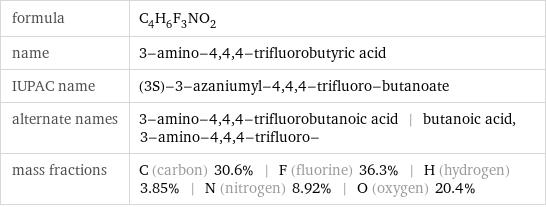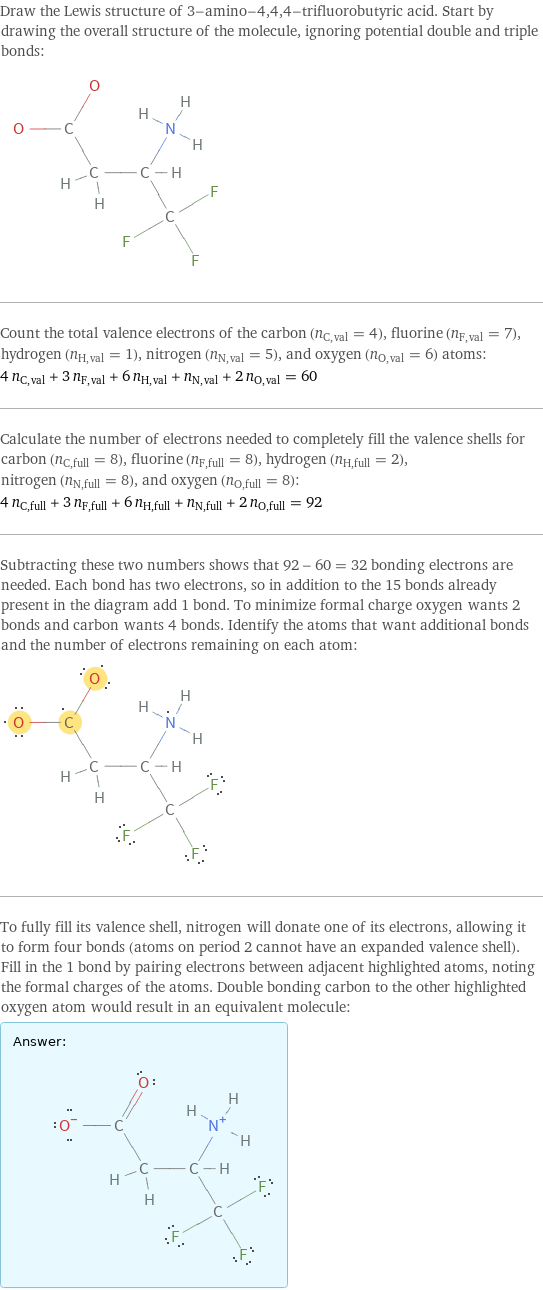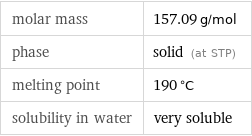Input interpretation

3-amino-4, 4, 4-trifluorobutyric acid
Chemical names and formulas

formula | C_4H_6F_3NO_2 name | 3-amino-4, 4, 4-trifluorobutyric acid IUPAC name | (3S)-3-azaniumyl-4, 4, 4-trifluoro-butanoate alternate names | 3-amino-4, 4, 4-trifluorobutanoic acid | butanoic acid, 3-amino-4, 4, 4-trifluoro- mass fractions | C (carbon) 30.6% | F (fluorine) 36.3% | H (hydrogen) 3.85% | N (nitrogen) 8.92% | O (oxygen) 20.4%
Lewis structure

Draw the Lewis structure of 3-amino-4, 4, 4-trifluorobutyric acid. Start by drawing the overall structure of the molecule, ignoring potential double and triple bonds: Count the total valence electrons of the carbon (n_C, val = 4), fluorine (n_F, val = 7), hydrogen (n_H, val = 1), nitrogen (n_N, val = 5), and oxygen (n_O, val = 6) atoms: 4 n_C, val + 3 n_F, val + 6 n_H, val + n_N, val + 2 n_O, val = 60 Calculate the number of electrons needed to completely fill the valence shells for carbon (n_C, full = 8), fluorine (n_F, full = 8), hydrogen (n_H, full = 2), nitrogen (n_N, full = 8), and oxygen (n_O, full = 8): 4 n_C, full + 3 n_F, full + 6 n_H, full + n_N, full + 2 n_O, full = 92 Subtracting these two numbers shows that 92 - 60 = 32 bonding electrons are needed. Each bond has two electrons, so in addition to the 15 bonds already present in the diagram add 1 bond. To minimize formal charge oxygen wants 2 bonds and carbon wants 4 bonds. Identify the atoms that want additional bonds and the number of electrons remaining on each atom: To fully fill its valence shell, nitrogen will donate one of its electrons, allowing it to form four bonds (atoms on period 2 cannot have an expanded valence shell). Fill in the 1 bond by pairing electrons between adjacent highlighted atoms, noting the formal charges of the atoms. Double bonding carbon to the other highlighted oxygen atom would result in an equivalent molecule: Answer: | |
3D structure

3D structure
Basic properties

molar mass | 157.09 g/mol phase | solid (at STP) melting point | 190 °C solubility in water | very soluble
Units

Chemical identifiers
![CAS number | 584-20-3 Beilstein number | 1764276 PubChem CID number | 1549685 SMILES identifier | C(C(C(F)(F)F)[NH3+])C(=O)[O-] InChI identifier | InChI=1/C4H6F3NO2/c5-4(6, 7)2(8)1-3(9)10/h2H, 1, 8H2, (H, 9, 10)/t2-/m0/s1/f/h8H NSC number | 381464](../image_source/e504660d780520562e4f664f3a8e3c82.png)
CAS number | 584-20-3 Beilstein number | 1764276 PubChem CID number | 1549685 SMILES identifier | C(C(C(F)(F)F)[NH3+])C(=O)[O-] InChI identifier | InChI=1/C4H6F3NO2/c5-4(6, 7)2(8)1-3(9)10/h2H, 1, 8H2, (H, 9, 10)/t2-/m0/s1/f/h8H NSC number | 381464
Toxicity properties

odor | odorless